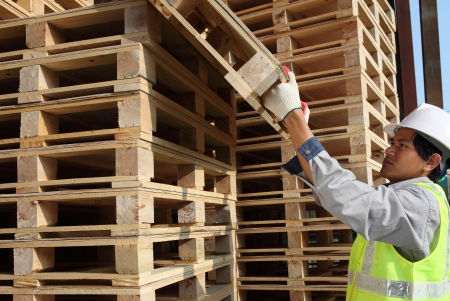Stacking Materials
Stacking materials can be dangerous if workers do not follow safety guidelines. Falling materials and collapsing loads can crush or pin workers, causing injuries or death. OSHA recently awarded severe penalties for improper stacking of boxes. Read about the citation.
To help prevent injuries when stacking materials, workers must do the following:
- Stack lumber no more than 16 feet high if it is handled manually, and no more than 20 feet if using a forklift;
- Remove all nails from used lumber before stacking;
- Stack and level lumber on solidly supported bracing;
- Ensure that stacks are stable and self-supporting;
- Do not store pipes and bars in racks that face main aisles to avoid creating a hazard to passersby when removing supplies;
- Stack bags and bundles in interlocking rows to keep them secure; and
- Stack bagged material by stepping back the layers and cross-keying the bags at least every ten layers (to remove bags from the stack, start from the top row first).
During materials stacking activities, workers must also do the following:
- Store baled paper and rags inside a building no closer than 18 inches to the walls, partitions, or sprinkler heads;
- Band boxed materials or secure them with cross-ties or shrink plastic fiber;
- Stack drums, barrels, and kegs symmetrically;
- Block the bottom tiers of drums, barrels, and kegs to keep them from rolling if stored on their sides;
- Place planks, sheets of plywood dunnage, or pallets between each tier of drums, barrels, and kegs to make a firm, flat, stacking surface when stacking on end;
- Chock the bottom tier of drums, barrels, and kegs on each side to prevent shifting in either direction when stacking two or more tiers high; and
- Stack and block poles as well as structural steel, bar stock, and other cylindrical materials to prevent spreading or tilting unless they are in racks.
In addition, workers should do the following:
- Paint walls or posts with stripes to indicate maximum stacking heights for quick reference;
- Observe height limitations when stacking materials;
- Consider the need for availability of the material; and
- Stack loose bricks no more than 7 feet in height. (When these stacks reach a height of 4 feet, taper them back 2 inches for every foot of height above the 4-foot level. When masonry blocks are stacked higher than 6 feet, taper the stacks back one-half block for each tier above the 6-foot level.)
Knowledge Check Choose the best answer for the question.
1-7. What is the maximum height for stacking lumber when manually handled?
You forgot to answer the question!

